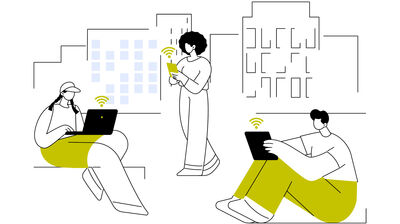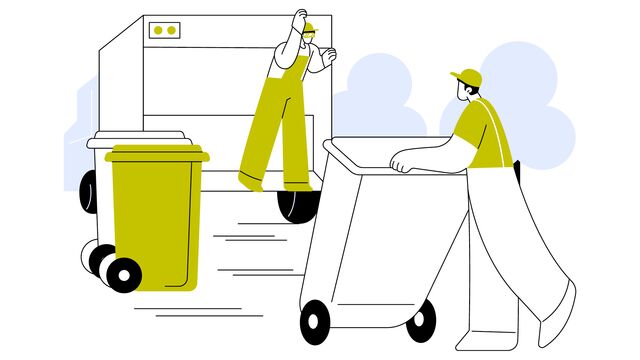Getting smart : Innovative ideas for the waste management industry
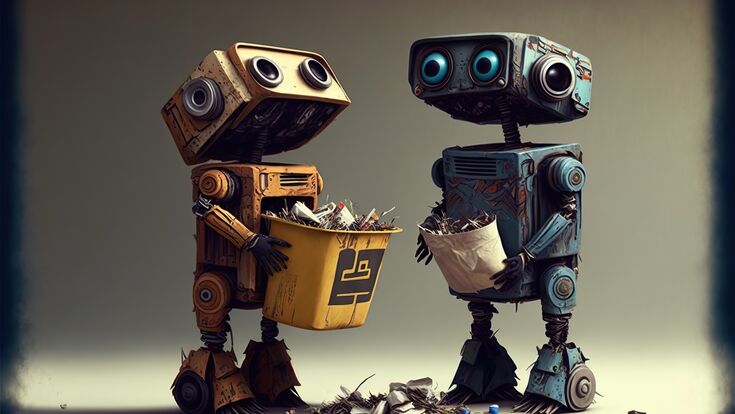
By the year 2050, the world is expected to generate 3.40 billion tonnes of waste annually. This means an increase of 70 per cent from the 2016 levels. The World Bank, in their report, What a Waste 2.0: A Global Snapshot of Solid Waste Management to 2050, published these staggering numbers back in 2018, calling for immediate action to stop this from happening. This surge is due to rapid urbanisation, population growth and the rise of consumer culture. And unfortunately, not much has happened since to mitigate waste generation.
The report points out that sound waste management systems are essential to building a circular economy, where products are designed and optimised for reuse and recycling. As national and local governments embrace the circular economy, the report states smart and sustainable waste management practices will help drive efficient economic growth while minimising environmental impacts.
Shift from guesswork to data analytics
And here it is, the word “smart”. The waste management industry has long seen that traditional technology will not suffice to deal with the deluge of trash we humans are producing each and every year. “Waste management has historically relied upon guesswork and manual processes and estimations. This approach often led to inefficiencies,” says Renaud de Viel Castel, Chief Operating Officer and Head of Global Expansion at Rubicon. Umutcan Duman, CEO of SaaS company Evreka agrees: “Using old-school methods can result in inefficiencies, errors, and higher costs in the age of cutting-edge technologies. Data-driven waste management technology represents a transformative shift from traditional approaches by combining the power of data and advanced analytics.”
A shift that combines two crucial points:
- The environmental impact: By optimising waste collection and reducing unnecessary movements, smart waste management systems help to reduce carbon emissions and the overall environmental impact of waste disposal.
- Cost Efficiency: Optimised operations and reduced waste of resources result in cost savings for waste management authorities and municipalities.
For the implementation of smart systems, there needs to be a general willingness to step away from traditional solutions. The experts furthermore recommend a holistic approach: "When contemplating the transition to a smart waste management approach, municipalities and waste management companies should go beyond just the technological aspect and consider a holistic strategy. It's important to define clear objectives and key performance indicators (KPIs) that align with the organisation's goals,” says Duman.
Like our content? Subscribe to our newsletters!
The future is smart
For all industry experts, it is clear that smart, AI-driven solutions will shape the industry more and more.
“Using AI, waste data will be better understood, interpreted, and predicted in the future,” says Garry Nemack, Team Leader of Sales & Contract Management Standard of Axians eWaste. “This will lead to better planning, optimisation, and decision-making in waste management.”
Or as de Viel Castel says: "I believe that the future promises a more intertwined relationship between cameras, sensors, and advanced analytics. We’re not just talking about mere data collection but delving into a realm where affordability meets ubiquity: every waste bin, every refuse type, every location becomes a data point.”
Another aspect must not be forgotten for Fabrizio Radice, Vice President and Head of Global Sales and Marketing at Tomra Recycling: “Deep learning is a game changer that will gain more attention with waste streams becoming more complex and sorting tasks more challenging. It will allow us to recover materials that can’t be recovered and distinguished with traditional technologies.”
Tomas Vincze, Waste Collection Management Division Director at Sensoneo, sums it up perfectly: “Digitisation and waste optimisation are the inevitable future.”
10 Smart Waste Management Solutions
Here are 10 smart waste management solutions shaping the industry right now:
1 Smart waste bins
Source separation plays an integral part in the recycling industry, but people don't always bother to put recyclables in the proper bin. Smart waste bins like the ones from the Polish company Bin-e use AI-based object recognition to automatically sort recyclables into separate compartments. Plastic and paper are then compressed to decrease the volume and reduce the emptying frequency. The machine is also equipped with fill-level sensors.
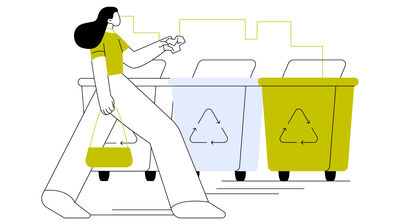
2 Waste level sensors
For decades, weekly garbage collection services have been the norm. But they are not always the most efficient option. In come the so-called fill or waste level sensors. They can monitor the fill level of the bin in real time and, as they are equipped with communication devices, send alerts when it's time for collection. The collected and stored data enables waste management companies to optimise collection routes, reduce unnecessary trips and minimise fuel consumption.
“Ultrasound technology is at the time the most suitable for any environmental conditions, whether indoors or outdoors,” explains Tomas Vincze, Waste Collection Management Division Director at Sensoneo. “Ultrasound is extremely effective and resistant to a dirty and dark environment inside waste bins.”
He adds: “In the future, we will see more accurate sensors with longer-lasting battery life. Sensors will be capable of measuring more environmental parameters, for example, the level of methane in the bin.”
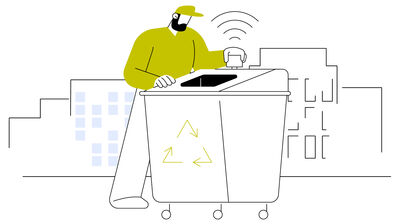
3 Route optimisation
Intelligent waste management systems use more than just the information from the waste level sensors to calculate the most optimal route. They can optimise collection routes by analysing data on fill levels, traffic conditions and other variables. This reduces the time, fuel and emissions associated with waste collection.
GPS technology also tracks waste collection vehicles and optimises collection routes. Minimising travel time and fuel consumption reduces operational costs and environmental impact.
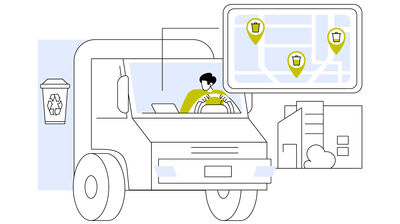
4 Smart Fleet Management
Using sensors, fleet management systems can monitor the health and performance of waste collection vehicles. This helps schedule maintenance proactively and ensures vehicles are operating efficiently.
5 Garbage trucks weighing mechanisms
Like the sensors installed in waste bins, those installed in garbage trucks help predict fill levels and reduce collections trips. They measure and store the weight of waste bins and, over time, can predict fill levels.
6 Data Analytics
Analysing all the data collected is at the core of most smart waste management systems. Advanced analytics software processes data collected from sensors and other sources to provide insights into waste generation patterns, allowing for better planning and resource allocation.
The data collected over time can provide valuable insights for long-term waste management planning, helping to make better decisions about waste reduction, recycling campaigns and infrastructure development. But of course, this process comes with its challenges, as Garry Nemack, Team Leader of Sales & Contract Management Standard of Axians eWaste, explains. “Managing and analysing large amounts of data requires careful data collection, cleansing, and integration. The data should be presented in an understandable and usable form, e.g. through visualisation, reporting, and dashboard tools.” Data protection obviously is something companies need to consider: “Data protection and security play an important role, as these technologies often collect, process, and transmit sensitive data about waste producers, collectors, and recyclers,” says Nemack. “This data can be, for example, personal data, company secrets, or environmental data that require a high level of protection against unauthorised access, manipulation, or loss.”

7 AI recycling robots
Robotic sorting systems driven by artificial intelligence and equipped with computer vision have gained prominence. These systems can efficiently separate recyclable materials from general waste, improving recycling rates and reducing contamination.
AI-driven recycling robots identify and sort recyclable materials, increasing efficiency and reducing the need for human workers (which regarding work safety is also a plus). These machines help divert materials from landfills or incineration and help recyclers save money in the long run.
“Thanks to AI-supported software and sensors - such as NIR, RGB cameras, magnetic (X-ray) sensors, and many more - recyclable materials can be recovered and sorted by both material type and colour, even the smallest plastic flakes. And this, at high throughputs,” says Fabrizio Radice, Vice President and Head of Global Sales and Marketing at Tomra Recycling. “With deep learning technology, sorting facilities can go even further. Depending on the application the neural network is trained for, deep learning sorting technologies can detect and recover materials that are hard or impossible to detect with conventional technologies, such as NIR sensors.”
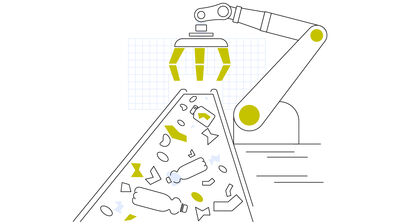
8 Pneumatic waste pipes
This is a departure from traditional waste collection. Some cities already have pneumatic waste disposal bins that are connected to an underground net of pipes installed. The waste travels through these pipes to the waste collection facilities, where it is sorted and/or transported to recycling plants or other facilities.
9 Mobile Apps
Smart waste management often involves communication channels with residents, such as mobile apps. Residents can use these apps to report problems, access collection schedules, and receive notifications. They also provide information on recycling, waste disposal, composting, and waste reduction strategies promoting public engagement and education. Many offer rewards and incentives for responsible waste disposal.
Some apps also connect users with local recycling and donation centres.
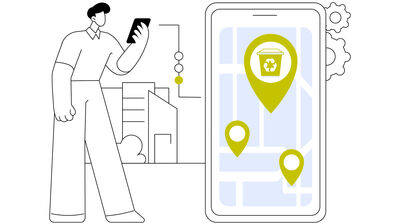
10 IoT and Sensors
IoT devices and networks are increasingly being integrated into waste management systems, enabling seamless communication between bins, collection vehicles and central control centres. This connectivity improves data sharing and coordination. It helps optimise waste collection routes, reduce costs, and prevent overflowing bins. “The IoT stands as a linchpin in the evolving waste management narrative, seamlessly interlinking elements like collection vehicles, dispatch boards, and even waste containers themselves,” says Renaud de Viel Castel, Chief Operating Officer and Head of Global Expansion at Rubicon. “The IoT is already bringing greater efficiencies into waste and recycling. But it’s not just about economics. The environmental benefits in the form of reduced greenhouse gas emissions, coupled with enhanced transparency and bolstered public health, underscore IoT’s pivotal role in reshaping the future of waste management.”
But there is one major obstacle, as Tomas Vincze explains: “There is still not sufficient infrastructure of IoT networks to implement the solution to all bins everywhere. You cannot implement the solution in the bin without network; it won't send you any data, so it is necessary to expand the network.”
